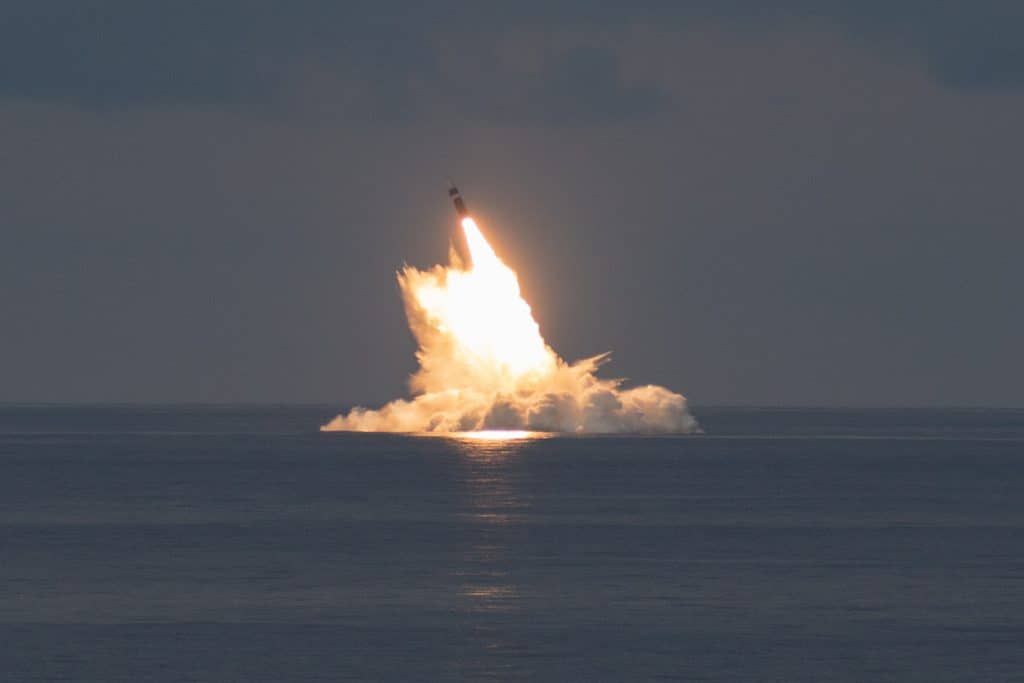Can the US President stop a new nuclear weapon he doesn’t want?
By Stephen Young | May 5, 2023
 An unarmed, life-extended version of the Trident II D5 missile launches from a ballistic missile submarine off the coast of Florida in September 2021. Credit: US Navy/David Holmes
An unarmed, life-extended version of the Trident II D5 missile launches from a ballistic missile submarine off the coast of Florida in September 2021. Credit: US Navy/David Holmes
There are not many issues where Democrats in Congress oppose President Biden and join Republicans in pushing forward something the president does not want. Unfortunately, one such issue is an unneeded new nuclear weapon known as the nuclear-armed sea-launched cruise missile.
President Biden is wisely seeking to cancel the weapon, which was first proposed by the Trump administration in 2018. Biden never liked it, calling it a “bad idea” back when he was a candidate for president, while the 2020 Democratic Party Platform had already declared it “unnecessary, wasteful, and indefensible.”
Despite Biden’s opposition, however, the US Congress gave the program $45 million last year. One of the reasons for that was the vehement public support for the weapon from the then-head of US Strategic Command, the military officer in charge of US nuclear forces.
Now, however, there is a new Strategic Commander who is less committed to the sea-launched cruise missile than his predecessor was. This may represent an opportunity to change how Congress responds to the president’s attempt to again cancel the weapon.
Rationale. The sea-launched cruise missile (SLCM-N) is just one potential—and relatively small—part of the on-going massive program to rebuild every piece of the US nuclear arsenal, at a cost likely to top $2 trillion dollars over the next three decades (about a third of the entire federal government spending of last year). Through this modernization program, the military-industrial complex is building new submarines, new land-based missiles, new stealthy bombers, new stealthy fighter aircraft, and new stealthy air-launched cruise missiles, plus a suite of all new nuclear warheads and bombs for those delivery vehicles to carry. It is an enormous, yet largely unnecessary undertaking.
There is currently too much political support in Washington for the rebuilding endeavor—particularly given Russia’s invasion of Ukraine and China’s moves to expand its small nuclear arsenal—to stop any part of this nuclear spending spree in the near-term. Except, maybe, for the SLCM-N.
The SLCM-N would be like a cruise missile that was withdrawn from service back in 1991 by President George H.W. Bush, as part of his effort to eliminate unneeded and excess nuclear weapons after the Cold War ended. That weapon, known as the Tomahawk land attack missile-nuclear, was removed from Navy surface ships and attack submarines and put in storage. Most in the Navy were happy to see it go, and happier still when the Obama administration’s Nuclear Posture Review decided to formally retire it in 2010.
As the 2010 review explained, the weapon was “redundant.” With all the nuclear and conventional capabilities the United States had already fielded, there was simply no need for yet another cruise missile type, particularly in light of all the costly replacement work already being done.
By the same rationale, therefore, the Biden administration’s 2022 Nuclear Posture Review cancelled the SLCM-N, declaring it “no longer necessary.” To implement that decision, in the Fiscal Year 2023 budget request that he sent to Congress in the spring of 2022, the president requested no money for both the cruise missile and the nuclear warhead it would carry.
In support of that decision, Secretary of Defense Lloyd Austin testified to Congress that “the marginal capability that this [weapon] provides is far outweighed by the cost.” The Secretary of the Navy, Adm. Carlos Del Toro, agreed, declaring “I believe that we should zero out the SLCM line. I believe the president has all the tools in his toolkit necessarily to deter and deal with the threat of a tactical nuclear missile.” Chief of Naval Operations Adm. Michael Gilday also supported cancelling the program, testifying that “I completely agree with the President and the Secretary of Defense.”
But not all military commanders adhered to the idea.
Shift in Congress. Despite the conclusions of the Nuclear Posture Review, Adm. Charles Richard, the then-head of US Strategic Command, wrote letters to and repeatedly testified before Congress in support of the SLCM-N. He argued that “a deterrence and assurance gap exists” that this cruise missile would fill, citing its low-yield, non-ballistic nature, and ability to generate without being observed. His early and strong support for the weapon led some Democrats in Congress—always afraid of being labelled “weak on defense”—to consider opposing their own president on this issue.
For at least a few, that willingness became a preference when Gen. Mark Milley, the chair of the Joint Chiefs of Staff, also endorsed the weapon, testifying that the president “deserves to have multiple options to deal with national security situations.” While he also declared that the United States has “lots of options and we have a significant nuclear capability,” his support gave some Democrats in the House enough reason to declare their support of the SLCM-N. Given House Democrats last year had a slim five-vote margin—and only two votes to spare on the key House Armed Services Committee that takes a first crack at the issue—it only took a few willing Democrats to give Republicans the majority they needed to fund the weapon.
With the votes in hand, Republicans struck a bargain with the Democratic leadership of the House Armed Service Committee. In exchange for including relatively modest funding of $45 million for the program in the first draft of the annual National Defense Authorization Act—a sign of bipartisan support for it—Republicans agreed to not offer amendments that would give the program even more money. The $45 million included $25 million in Navy funding for research on the cruise missile, and $20 million for initial work on the nuclear warhead it would carry.
That bargain served supporters of the SLCM-N well. In an appropriations process that, in a normal year, has final say on what level of funding any government program gets, the House appropriations committee gave unified Democratic support for the president, providing no funding for the SLCM-N. The Senate Appropriations committee was split, allocating $25 million for the cruise missile but no money for the nuclear warhead. Meanwhile, the Senate National Defense Authorization Act mimicked what happened in the House version of the bill, providing $45 million.
Unfortunately for the president, however, when the appropriations bills could not be passed by regular process, all the decisions on funding ended up being made by the House and Senate leadership. Even though the House and Senate were under Democratic control, Republican doggedness on the issue and the bipartisan support shown in the House Armed Services Committee were enough to lead to $45 million in appropriations for the unneeded SLCM-N.
New year, new Congress. Now it is a new year, and Congress will again debate the issue. As in the last fiscal year, the president’s annual budget request to Congress does not ask for any money for the SLCM-N.
One significant difference this year is the views of the new head of US Strategic Command, Gen. Anthony Cotton. Like his predecessor, Cotton wrote a letter to Congress about the SLCM-N. However, instead of offering explicit support for the program, General Cotton provided a much more nuanced view. He said he supported the capabilities that that SLCM-N would offer—the same ones Admiral Richard wanted. But Cotton added that the SLCM-N was “one of several possible nuclear or conventional capabilities” (emphasis added) that could be developed to fill those roles.
In sum, while he would like more options, Cotton does not view the SLCM-N as something he must have in his role as head of Strategic Command.
This should support the Biden administration’s decision to cancel the program. Indeed, when General Cotton testified before the House Armed Services Committee, he was not even asked about the issue. Instead, another administration official, John Plumb, the Assistant Secretary of Defense for Space Policy, took the question and gave the administration’s answer, that they would like to cancel the program.
This is also a new Congress, one where Republicans control the House. Given the aggressive rhetoric many Republicans have been uttering on nuclear weapons issues, a major increase in funding for the SLCM-N will be one of numerous attempts to expand or speed up the massive on-going plan to rebuild the entire US nuclear arsenal.
The issue will now logically come down to the Senate, where Democrats retain a slim majority. Unfortunately, initial signs are not encouraging. In a March hearing of the Strategic Forces subcommittee of the Senate Armed Services Committee, Sen. Angus King (R-Maine), who chairs the subcommittee, offered support for the SLCM-N, as did all the witnesses that were invited to testify. At another hearing in April, Sen. King—this time with administration witnesses—specifically called on the administration to reconsider the cancellation.
If President Biden and his administration want to cancel the SLCM-N, they will need to make a stronger case than they have to date. For example, Secretary of Defense Austin could write an op-ed making the case why the program is unneeded. The National Nuclear Security Administration, responsible for developing, building and maintaining US nuclear weapons, could also make it clear that it already has more work on its plate than it can possibly accomplish. The Navy could elaborate on why it opposes the SLCM-N and how it would be an impediment to the many other more important programs. The president himself could weigh in with key senators.
Unless one—or several—of these changes happen, Congress likely will fund for one more year a new nuclear weapon that the President of the United States does not want. And that truly would be an unfortunate situation.
Together, we make the world safer.
The Bulletin elevates expert voices above the noise. But as an independent nonprofit organization, our operations depend on the support of readers like you. Help us continue to deliver quality journalism that holds leaders accountable. Your support of our work at any level is important. In return, we promise our coverage will be understandable, influential, vigilant, solution-oriented, and fair-minded. Together we can make a difference.














